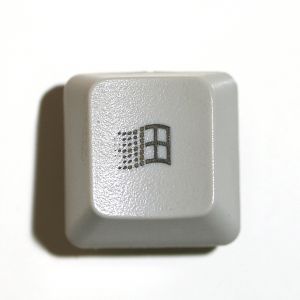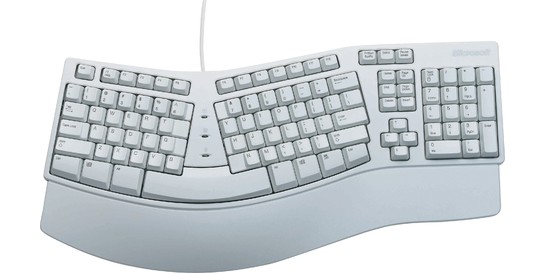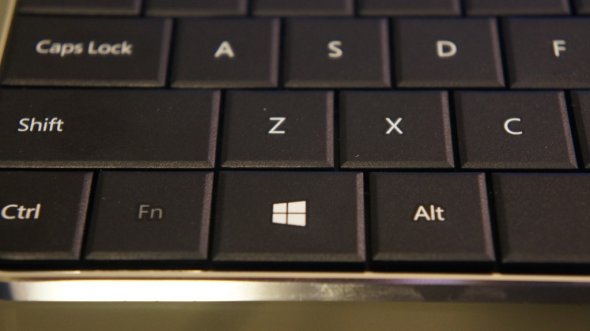| Nos esforzamos para localizar nuestro sitio web en tantos idiomas como sea posible, sin embargo, esta página no está traducida máquina usando Google Translate. | cerca |
-
-
productos
-
recursos
-
soporte
-
empresa
-
La clave de Windows: Todo lo que usted siempre quiso saberThe Windows Key: Everything You Ever Wanted to Know
Por Steve Horton Noviembre 20, 2012Windows 7, windows 8, windows key, windows vista, Windows XPNo hay comentariosSi has usado una PC durante mucho tiempo, sabrías que el teclado de la PC experimentó un cambio radical hace más de 15 años, y se ha mantenido igual desde entonces. Alrededor de 1995, ganó tres nuevas claves: un par de teclas de Windows y una tecla de menú. (En algunas computadoras portátiles, falta la clave adicional.) Vamos a hablar sobre la primera, la clave de Windows. De dónde vino, qué hace y cómo puede usarlo para moverse por Windows más fácilmente.

Así es como se veía originalmente la clave de Windows.Historia de la clave de Windows
La clave de Windows apareció por primera vez antes del lanzamiento de Windows 95 en el Microsoft Natural Keyboard. ¿Recuerdas ese teclado de dos niveles pensado para reducir las lesiones por estrés que era casi imposible de escribir? Poco después del lanzamiento de Win 95, esta tecla comenzó a aparecer en teclados y computadoras portátiles en todas partes. El logotipo de la llave incluso ha cambiado varias veces para coincidir con el logotipo que se encuentra en la versión actual de Windows. Incluso la tableta Microsoft Surface tiene un botón de pantalla de inicio de Windows de hardware que imita la funcionalidad de la clave de Windows.

El teclado natural es donde apareció por primera vez la clave de Windows.¿Qué hace la clave de Windows?
En todas las versiones de Windows desde Windows 95 hasta Windows 7, al tocar esta tecla aparecerá el menú Inicio. Es una forma realmente útil de ingresar a ese menú sin tener que mover el mouse hacia la esquina inferior izquierda y hacer clic en Iniciar.
En Windows 8, al tocar la tecla de Windows desde el escritorio, accederá a la pantalla de inicio. Al presionar la misma tecla desde la pantalla de inicio, volverá al escritorio.

El logotipo de Windows Key ahora coincide con Windows 8.¿Cuáles son algunos de los accesos directos clave de Windows?
Aquí hay algunos atajos de teclado realmente útiles que incluyen la tecla de Windows.
Windows XP o posterior
Windows Key + D : borre todas las ventanas y muestre el escritorio de Windows. Sin embargo, si se presiona mientras está en la pantalla de inicio de Windows 8, tiene el mismo efecto que presionar la tecla Windows desde allí.
Windows Key + F : busca archivos. Las versiones posteriores de Windows realizan búsquedas mucho más rápidamente que las versiones anteriores.
Windows Key + L : bloquea el escritorio. Si Windows está protegido por contraseña, pedirá la contraseña para salir de la pantalla de bloqueo.
Windows Vista o posterior
Windows Key + Tab : Aero Flip. (No funciona en Windows 8.) Esta es una herramienta de cambio de aplicaciones 3D que es mucho más llamativa pero no mucho más útil que Alt + Tab.
Windows Key + a Number : inicia un programa desde la barra de tareas. Windows Key + 1 ejecuta el programa más a la izquierda y Windows Key + 0 ejecuta el décimo desde la izquierda. Si la aplicación ya está abierta, este acceso directo cambiará a ella.
Windows 7 o posterior
Tecla + T de Windows para recorrer elementos en la barra de tareas, de izquierda a derecha.
Tecla de Windows + tecla de flecha para realizar Aero Snap. La flecha hacia arriba maximiza la ventana. La flecha izquierda lo ajusta a la mitad izquierda de la pantalla, la flecha derecha lo ajusta al lado derecho de la pantalla y la flecha abajo lo mimetiza.
Solo Windows 8
Tecla de Windows + C para abrir la barra de hechizos en el lado derecho de la pantalla.
Windows Key + X para abrir el menú Power User, que le ofrece muchas de las funciones perdidas con el menú de inicio que falta, como el acceso al panel de control, el cuadro de diálogo Ejecutar y el símbolo del sistema.
¿Qué pasa si no tengo una clave de Windows?
Puede haber casos en los que tenga un teclado viejo por ahí, probablemente un teclado en serie, en lugar de un teclado USB, o esté usando un teclado inalámbrico diseñado para otro sistema operativo. En ese caso, presionar Ctrl + Esc le dará algunas de las mismas funciones que presionar la tecla de Windows. Sin embargo, no puede combinar Ctrl + Esc y ninguna otra tecla para activar los accesos directos de Windows. Ctrl + Esc solo sirve para acceder al menú de inicio o a la pantalla de inicio.
Usa la tecla de Windows
Al igual que yo, puede hacer clic en Iniciar de forma más natural que presionar una tecla en el teclado que todavía no está acostumbrado. Sin embargo, es una buena idea familiarizarse con la clave de Windows y todos sus usos. Si alguna vez actualiza a Windows 8 , por ejemplo, esta clave es absolutamente esencial para moverse. Incluso si no lo hace, los atajos de teclado solo le ahorrarán mucho tiempo.
Was this post helpful?YesNoGratis Actualizaciones de controladores
Actualiza tus drivers en menos de 2 minutos para disfrutar mejor rendimiento de la computadora - Gratis.
Gratis Actualizaciones de controladores
Actualiza tus drivers en menos de 2 minutos para disfrutar mejor
rendimiento de la computadora - Gratis.
¿No ha encontrado la respuesta?Haz una pregunta a nuestra comunidad de expertos de todo el mundo y recibir una respuesta en ningún momento a todos.most relevant artículos recientes Copyright © 2025 Corel Corporation. Todos los derechos reservados. Términos de Uso | Privacidad | CookiesFijarlo en Pinterest